10 Birds That Look Like Eagles (With Pictures)
Last Updated on
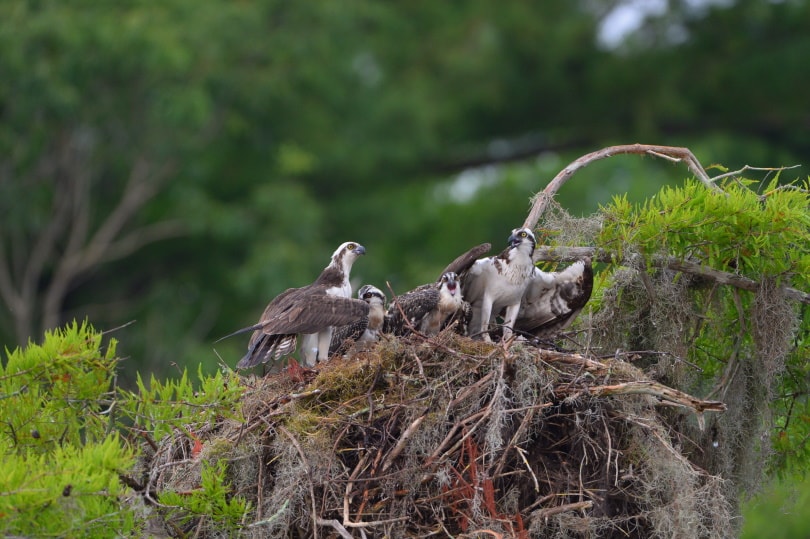
Eagles are some of the most recognizable birds of prey, and there are approximately 60 species living on every continent except Antarctica. Although the massive birds seem to dominate the skies wherever they live, several other species of large avian predators have similar characteristics and behaviors. Vultures, hawks, and falcons resemble eagles when flying, but you can spot differences in the birds when they’re standing still.
We’ll look at 10 remarkable birds often mistaken for eagles.

Top 10 Birds That Look Like Eagles
1. Andean Condor

| Wingspan | 8.9–10 feet |
| Weight | 17–33 pounds |
As the largest bird of prey on the planet, the Andean condor is a breathtaking sight with its massive wingspan and graceful flight. Unlike other New World vultures, the male and female Andean condors are much different in size and appearance. Both sexes have black bodies and featherless heads, but the male has a comb on his head and yellow eyes. Females do not have combs, and they’re much smaller and have red eyes.
The birds soar above the Andes Mountains of South America and search for prey. Andean condors are scavengers, but they sometimes feed on live newborn animals like goats or cows. When condors submerge their heads into dead animals to feed, their bald heads prevent bacteria from infecting their heads and faces. Condors soar much like eagles in flight, but the condor’s hairless head contrasts the eagle’s feathered one.
2. Black Kite
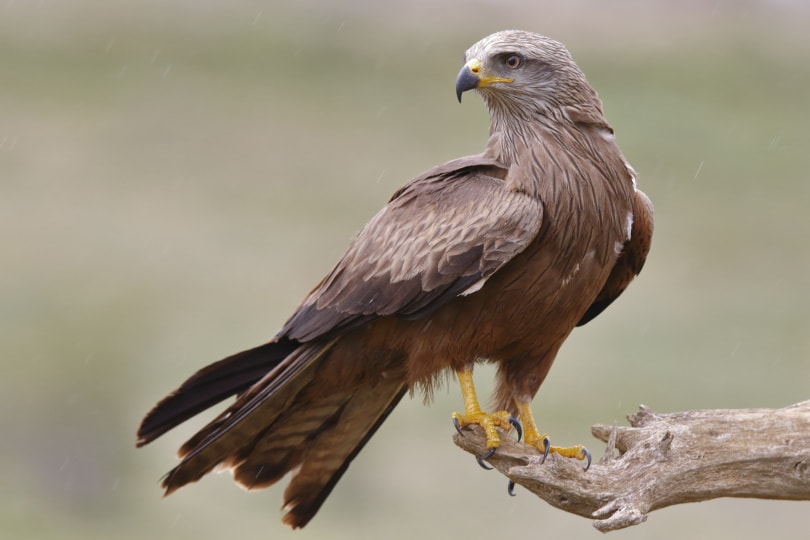
| Wingspan | 4.92 feet |
| Weight | 1.6 pounds |
The black kite is found in Asia, Europe, Africa, and Australia. It has a large global population, but its numbers have been declining due to poisoning, water pollution, pesticide ingestion, and shooting. With dark plumage and a forked tail, the black kite is a medium-sized bird that soars above the landscape and swoops down to catch prey or feed on carrion. They’re abundant in urban areas and are known to raid garbage containers for scraps, but they also feed on bats, fish, eggs, rodents, and nesting waterfowl.
The male and female kites participate in nest building and raising and protecting their offspring. Humans and other intruders who come too close to their nests are often met with diving attacks from the parents. Although it’s near the top of the food chain, the black Kite’s natural predator is the Eurasian eagle-owl.
3. Black Vulture

| Wingspan | 4.4–5.5 feet |
| Weight | 2.6–4.3 pounds |
Black vultures are native to North and South America, but their habitats in North America are limited to the southeast. They have bald gray heads and all-black plumage except for a few white feathers under the wingtips. Black vultures are family-oriented birds that often fly in flocks at high altitudes.
Because the birds have a weak sense of smell, the birds soar above turkey vultures and follow them when prey is spotted. Unlike other raptors, Black vultures do not have a voice box, and they rely on hisses and grunts for communication. They feed primarily on carrion but will also raid other birds’ nests for eggs and feast on baby herons and cattle. When the vultures go hunting for dead animals, they often bring back food for their relatives.
4. Northern Goshawk

| Wingspan | 35–50 inches |
| Weight | 1.4–3 pounds |
Unlike other predatory birds, the Northern goshawk prefers perching in the trees to spot prey and often jumps from branch to branch while watching the target below. The hawks are found in Europe, Asia, and North America, but the largest population lives in the forested regions of Canada. Goshawk parents mate for life, and they’re particularly aggressive at defending their nests from humans and other animals. Their diet consists of rodents, snakes, insects, rabbits, squirrels, and even small birds like crows and grouse.
Northern goshawks have blue-gray or brown feathers with speckled brown or black and white breasts. They’re talkative birds that use different calls to indicate danger, mating intentions, and when they’re bringing food.
5. Northern Harrier
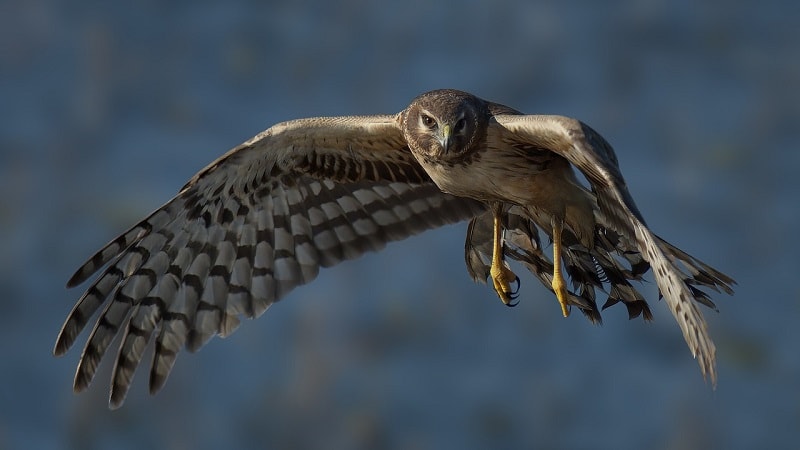
| Wingspan | 38–48 inches |
| Weight | 10–26 ounces |
Most raptors enjoy hunting in forested areas, but the Northern harrier prefers grasslands and wetlands to look for food. They fly low over grassy regions so they can detect rodents and small birds with their advanced hearing. Northern harriers have a circular patch of feathers on their heads that helps direct the sound to their ears. Females have brown wings while males have dull-gray plumage, but both sexes have a white rump patch visible in flight.
The Northern harrier is the only harrier with a North American habitat, and it lives as far south as Mexico and as far north as Alaska. Unlike other birds in the raptor family, Northern harriers have polygamous relationships; some males will mate with five females during a season.
6. Prairie Falcon

| Wingspan | 40 inches |
| Weight | 1.6 pounds |
Prairie falcons live in the western regions of North America, and they’re often mistaken for peregrine falcons. They’re related to the early peregrine ancestors, but their desert habitat allows them to survive on fewer meals than peregrines. Prairie falcons have sandy brown feathers, a white line over the eyes, and lighter-colored tail feathers. They hunt small mammals like gophers, prairie dogs, and small birds such as starlings, doves, quail, and meadowlarks. When prairie falcons compete with other eagles or hawks for food, they sometimes attack and kill larger raptors. In North America, the bird is a popular choice for falconers.
7. Red-Tailed Hawk
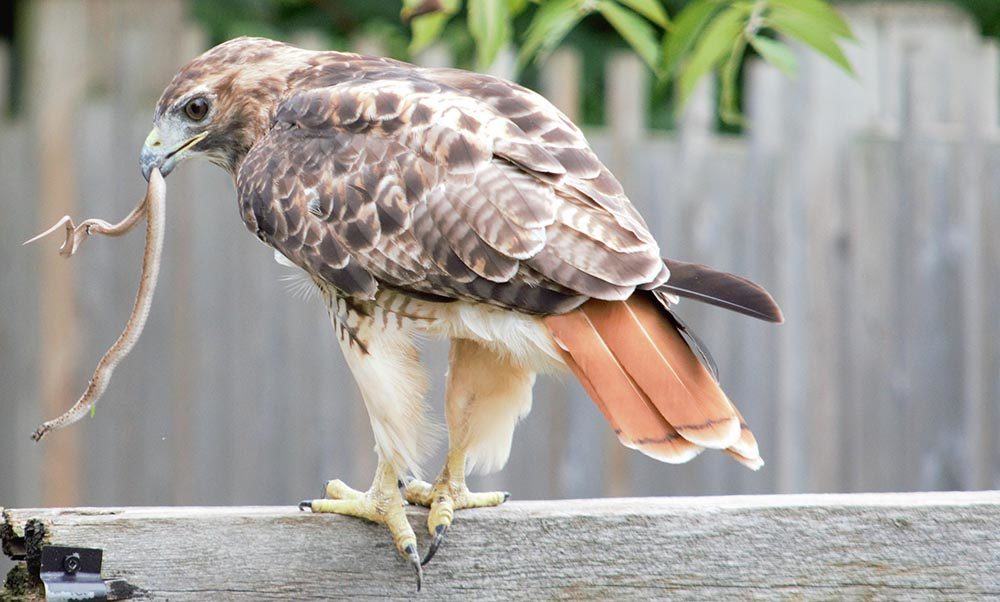
| Wingspan | 3.61–4.63 feet |
| Weight | 1.5–3.5 pounds |
Red-tailed hawks have one of the largest raptor populations in North America. They have mottled brown plumage, a curved beak, and sharp talons for grabbing prey. Although they nest in the deep forest for privacy, they often perch on telephone poles near roadways to search for food. Red-tailed hawks typically fly to 200 or 300 feet and swoop down at a 45° angle to catch their prey. Their diet includes rabbits, rodents, insects, and amphibians. The birds are skilled predators that rarely miss their targets, but they’re often preyed on by great-horned owls and bobcats. Great-horned owls sometimes take over the hawks’ territory to hunt at night.
8. Rough-Legged Hawk

| Wingspan | 47–60 inches |
| Weight | 1.32–3.66 pounds |
The rough-legged hawk nests in the arctic regions of North America, and its name describes the feathered legs that protect it in colder climates. North American rough-legged hawks migrate to northern and central areas of the United States. The hawks depend on lemmings and voles for food in the summer and hunt birds, frogs, insects, and rodents. Rough-legged hawks often set up nest sites on high cliffs and the tops of trees. They have brown-speckled plumage and white feathers under their wings, but light and dark variations require extensive experience to identify correctly. Adults have shrill whistling calls that provide warnings when a predator comes too close to the nest.
9. Turkey Vulture

| Wingspan | 63–72 inches |
| Weight | 1.8–5.3 pounds |
Also called the buzzard or turkey buzzard, the turkey vulture has a hairless red head and black feathers similar to a wild turkey. Turkey vultures lack a voice box and can only hiss and grunt, but they’re incredibly social birds that often hunt in groups. At night, dozens of vultures will sit close together to sleep. They survive off carrion and live in North and South America. Unlike other birds of prey, turkey vultures have a highly developed sense of smell that helps them detect the gas produced by rotting flesh. They’re often seen gliding in thermals in circular patterns to survey the land for food.
10. Western Osprey
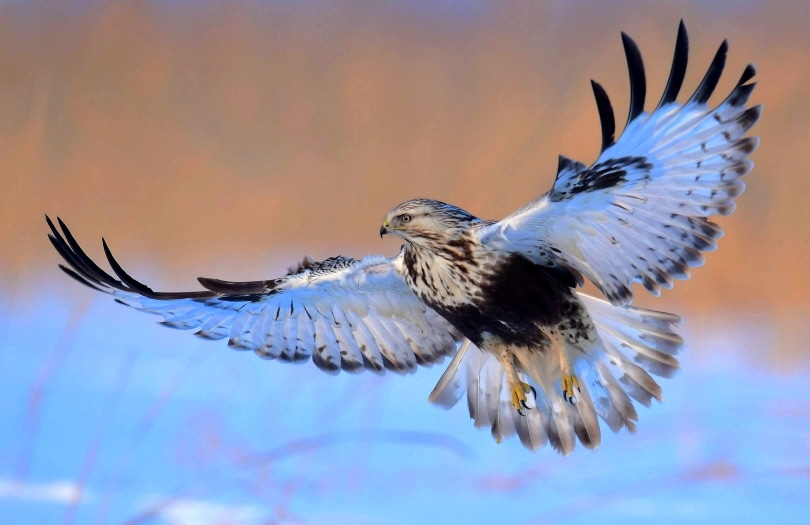
| Wingspan | 50–71 inches |
| Weight | 2–4.63 pounds |
Western Ospreys are large, majestic predators that can be found on every continent except Antarctica. They have long brown wings, white bellies, and gray heads. Their reversible toes make them unique to raptors, although they share the characteristic with owls. Having reversible outer talons help the bird hold on to its slippery meals. Ospreys survive almost entirely on fish, and they have perfected a technique that involves circling above and then diving feet-first into the water. Their feathers are coated with a protective oil to prevent them from becoming waterlogged, and they often become completely submerged when hunting for fish. Like the northern goshawks, ospreys mate for life. Except for Antarctica, every continent with tropical and temperate zones has osprey populations.

Conclusion
When you see hawks, falcons, vultures, and other enormous avian species up close, you can see the difference from eagles. In the air, the birds appear more similar. Their impressive wingspans allow them to float high in the clouds without flapping, and their effortless flights contrast the frantic movements of smaller birds. Eagles are graceful in the air, but you have several species to observe that display the same aerial mastery.
Featured Image Credit: Jemini Joseph, Shutterstock
About the Author Robert Sparks
Robert’s obsession with all things optical started early in life, when his optician father would bring home prototypes for Robert to play with. Nowadays, Robert is dedicated to helping others find the right optics for their needs. His hobbies include astronomy, astrophysics, and model building. Originally from Newark, NJ, he resides in Santa Fe, New Mexico, where the nighttime skies are filled with glittering stars.
Related Articles:
Monocular vs Telescope: Differences Explained (With Pictures)
10 Types of Hummingbirds in Arkansas (With Pictures)
8 Types of Hummingbirds in Nebraska (With Pictures)
5 Types of Hummingbirds in Idaho (With Pictures)
3 Types of Hummingbirds in Mississippi (With Pictures)
8 Types of Hummingbirds in Kansas (With Pictures)
5 Types of Hummingbirds in West Virginia (With Pictures)
5 Types of Hummingbirds in Ohio (With Pictures)
